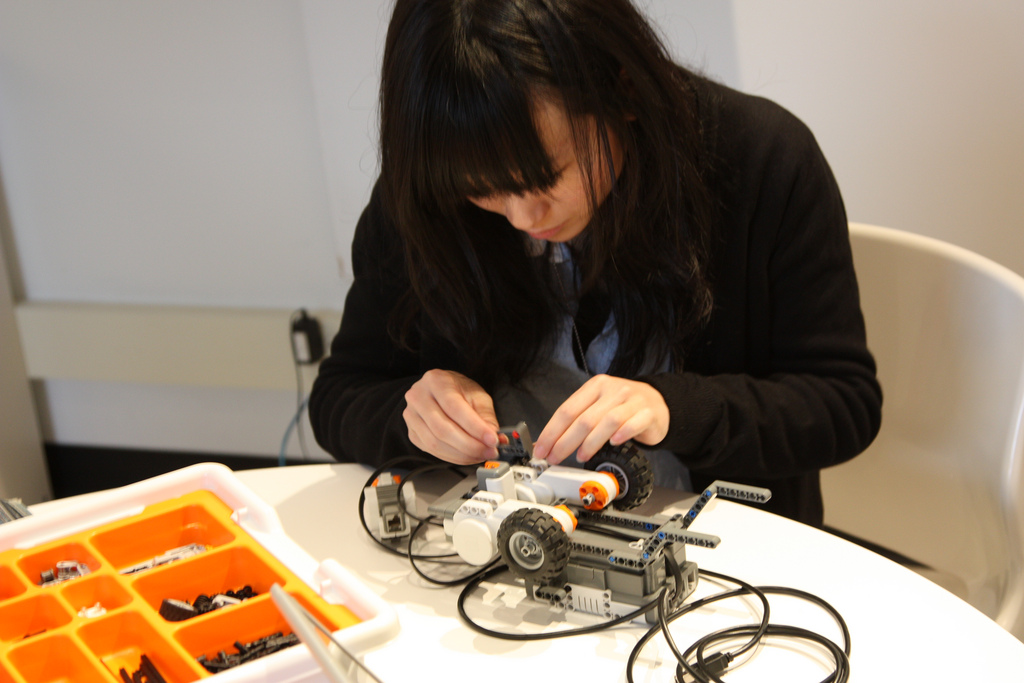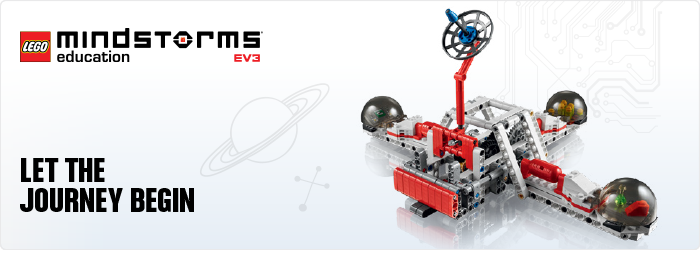
Lego Mindstorms for Education adds teacher training and other classroom-centered elements to help market the robotics system.
Lego is helping students welcome our new robot overlords to the classroom.
In a market that’s becoming flooded with tech companies venturing into the educational domain, one of the original maker games still seems to stand out: Lego and its Mindstorms for Education line. In addition to harnessing a thriving commercial market, this classic robotics building and programming tool is used heavily in after school programs and classrooms across the globe. So how do they do it? How does an educational tool hold its own in a sea of new and exciting robotics games?
The team at Lego Mindstorms for Education believes the answer is clear: Learning comes first.
“The end isn’t to build a cool robot; the end is to learn STEM concepts from a curriculum standpoint, and then from a 21st-century learning standpoint to learn things like creative problem solving, critical thinking, collaboration [and] perseverance,” said Abigail Fern, Marketing Director for Lego Education. For Lego Education, it’s about using robotics to teach a broad array of skills in the STEM (Science, Technology, Engineering and Math) fields, and less about the robots themselves.

More and more schools are picking up on these kinds of broad applications of robotics in the classroom, and much of that shift can be credited to an increasing worldwide emphasis on hands-on learning in STEM and beyond. What was once the domain of after-school clubs and extracurricular activities has moved into the mainstream classroom, and Lego Education is working to use that shift not only as a business opportunity but to fundamentally change the way students are taught certain skills through their Mindstorms line.
Lego Mindstorms is riding the STEM wave into the classroom by developing cohesive tools for teachers, built right into the robotics package.
“We develop curriculum packs, or activity materials, that address different needs. It can either be across STEM, touching on applied math, science, technology and engineering, but we also have some more dedicated things,” said Peter Thesbjerg, Senior Marketing Manager for Lego Education. Those resources include targeting topics such as physical sciences – measuring friction, gravity, the boiling point and the like – and providing a curriculum grid which allows teachers to be sure that local and national standards are being met through the Mindstorms experience. Thesbjerg and Fern say Mindstorms products are easy for teachers to use, even if they’ve never used robotics programs before, thanks to the company’s emphasis on teacher training.
But the digital programming and STEM education that comes with Mindstorms doesn’t do much without kid appeal – a factor that Lego seems to have locked down as well. Lego Mindstorms works through a visual programmable interface that communicates with specially developed programmable Lego bricks, souped up with motors and multiple sensors. Students build their own robot, set that robot on a task and then reevaluate and tweak their creations based on the outcome – an iterative process that Thesbjerg emphasizes is crucial to complex learning, but that is also empowering and fun for students to use.
The product’s interface includes an integrated workbook, with links to sample programs and digitized instructions for building specific projects. Students can add programs and take photos of their creations, all of which are then included in a digital portfolio teachers can use in the assessment and evaluation process. The interface and the robots themselves are where the fun of building meet educational assessment needs.
Lego Mindstorms for Education appears to be hitting the marketing bulls-eye: According to Fern, Lego Mindstorms are currently in one-third of middle school classrooms across the U.S. But how is a classic building game seemingly so successfully harnessing the educational market?
Part of the organizational success at Lego involves careful bifurcation of the Mindstorms’ experience: Thesbjerg’s division has nothing to do with the consumer version of the product, allowing his team to focus “110 percent” on the educational experience.
Thesbjerg said each division caters to a different first-time experience for users, which allows Mindstorms for Education to focus on learning.
We develop all of our products not for students, but for teachers, because teachers are our customers. If we cannot get the teachers involved and convinced that they can see themselves teaching using our materials, then we don’t have a chance.
— Peter Thesbjerg, Senior Marketing Manager for Lego Education
That’s not to say, however, that the two divisions never meet. Strategic overlap in development allows for the creation of one product that is then tailored to meet the needs of the school and home environments. The school version and the toy version include different sensors, for example: gyro sensors for work in science at school, and infrared sensors for kids to get creative at home The school version comes packaged in a reusable plastic storage tray, while the toy version comes in a standard cardboard box. Lego also recognizes the potentially cost-prohibitive nature of robotics in schools, so while the toy version calls for standard AA batteries, the classroom version of Mindstorms includes a rechargeable battery pack and charger.
According to the Lego team, keeping the education world distinct from the toy world is part of what makes Lego Mindstorms for Education work – but that’s not to say they don’t operate as part of the larger Lego ecosystem. Thesbjerg credits part of Mindstorms’ success in the education market to careful brand cultivation within the massive Lego ecosystem, noting that the Lego brand is itself a powerful tool to leverage Mindstorms as a sub-brand.
It’s a sophisticated model, and one that seems to be working – but Lego Mindstorms have had plenty of time to refine their organizational model. Robotic Lego products have been on the map since 1986, when the first computerized Lego came onto the scene. Mindstorms themselves became an entity in 1998 in collaboration with MIT, and in the nearly twenty years since has evolved through numerous systems and iterations to become the most recent version, the EV3.
Released for education in August 2013 and for home use in September of that year, the latest version includes the EV3 Intelligent Brick, the programmable computer that controls the motors and gathers feedback from the various sensors. And now, since this spring, the EV3 can be programmed using a mobile tablet application that allows for greater mobility both in the classroom and in after-school robotics programs such as those affiliated with First Lego League.
That being said, teachers can and do face challenges when they want to bring robotics into the classroom, not least of which is cost. Although Lego does not provide grant funding themselves, Lego education does cultivate a site that includes advice for finding and writing grants as well as ready-made language to include that specifically details the benefits of their various educational products. According to Fern, Lego also keeps the educational budget in mind when pricing the Mindstorms products.
Lego Mindstorms for Education help kids learn through hands-on robotics building and programming in a research- and standards-based model of curricular involvement. The key to this model, Fern and Thesbjerg agree, is emphasis on the needs of educators. To that end, Lego monitors a robust online Mindstorms community of educators. While teachers are gleaning information from one another about creative ways to use robotics in class, they are also alerting the company to potential fixes and improvements to the product, software and curriculum resources.
